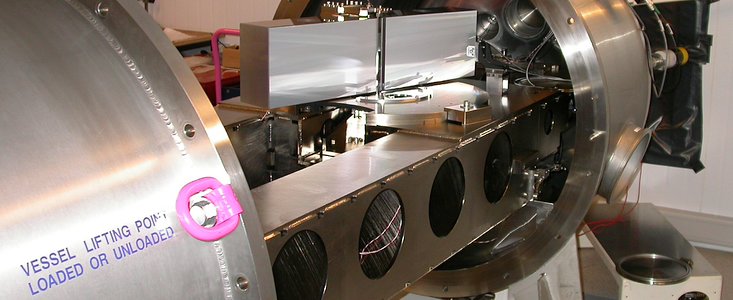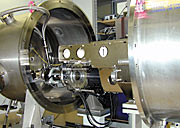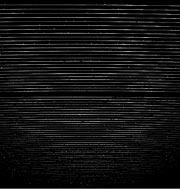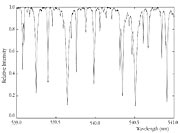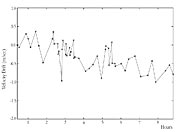Pressemitteilung
"First Light" for HARPS at La Silla
Advanced Planet-Hunting Spectrograph Passes First Tests With Flying Colours
27. März 2003
The initial commissioning period of the new HARPS spectrograph (High Accuracy Radial Velocity Planet Searcher) of the 3.6-m telescope at the ESO La Silla Observatory has been successfully accomplished in the period February 11 - 27, 2003. This new instrument is optimized to detect planets in orbit around other stars ("exoplanets") by means of accurate (radial) velocity measurements with an unequalled precision of 1 meter per second . This high sensitivity makes it possible to detect variations in the motion of a star at this level, caused by the gravitational pull of one or more orbiting planets, even relatively small ones. "First Light" occurred on February 11, 2003, during the first night of tests. The instrument worked flawlessly and was fine-tuned during subsequent nights, achieving the predicted performance already during this first test run. The measurement of accurate stellar radial velocities is a very efficient way to search for planets around other stars. More than one hundred extrasolar planets have so far been detected , providing an increasingly clear picture of a great diversity of exoplanetary system. However, current technical limitations have so far prevented the discovery around solar-type stars of exoplanets that are much less massive than Saturn, the second-largest planet in the solar system. HARPS will break through this barrier and will carry this fundamental exploration towards detection of exoplanets with masses like Uranus and Neptune. Moreover, in the case of low-mass stars - like Proxima Centauri - HARPS will have the unique capability to detect big "telluric" planets with only a few times the mass of the Earth. The HARPS instrument is being offered to the research community in the ESO member countries, already from October 2003.
The HARPS Spectrograph
HARPS is a unique fiber-fed "echelle" spectrograph able to record at once the visible range of a stellar spectrum (wavelengths from 380 - 690 nm) with very high spectral resolving power (better than R = 100,000). Any light losses inside the instrument caused by reflections of the starlight in the various optical components (mirrors and gratings), have been minimised and HARPS therefore works very efficiently .
First observations
During the first commissioning period in February 2003, the high efficiency of HARPS was clearly demonstrated by observations of a G6V-type star of magnitude 8. This star is similar to, but slightly less heavy than our Sun and about 5 times fainter than the faintest stars visible with the unaided eye. During an exposure lasting only one minute, a signal-to-noise ratio (S/N) of 45 per pixel was achieved - this allows to determine the star's radial velocity with an uncertainty of only ~1 m/s! . For comparison, the velocity of a briskly walking person is about 2 m/s. A main performance goal of the HARPS instrument has therefore been reached, already at this early moment.
This result also demonstrates an impressive gain in efficiency of no less than about 75 times as compared to that achievable with its predecessor CORALIE. That instrument has been operating very successfully at the 1.2-m Swiss Leonard Euler telescope at La Silla and has discovered several exoplanets during the past years. In practice, this means that this new planet searcher at La Silla can now investigate many more stars in a given observing time and consequently with much increased probability for success.
Extraordinary stability
The goal of measuring velocities of stars with an accuracy comparable to that of a pedestrian has required extraordinary efforts for the design and construction of this instrument. Indeed, HARPS is the most stable spectrograph ever built for astronomical applications . A crucial measure in this respect is the location of the HARPS spectrograph in a climatized room in the telescope building. The starlight captured by the 3.6-m telescope is guided to the instrument through a very efficient optical fibre from the telescope's Cassegrain focus.
Moreover, the spectrograph is placed inside a vacuum tank to reduce to a minimum any movement of the sensitive optical elements because of changes in pressure and temperature. The temperature of the critical components of HARPS itself is kept very stable, with less than 0.005 degree variation and the spectrum therefore drifts by less than 2 m/s per night. This is a very small value - 1 m/s corresponds to a displacement of the stellar spectrum on the CCD detector by about 1/1000 the size of one CCD pixel, which is equivalent to 15 nm or only about 150 silicon atoms! This drift is continuously measured by means of a Thorium spectrum which is simultaneously recorded on the detector with an accuracy of only 20 cm/s.
ESO Press Photo eso0308 illustrates two fundamental issues: HARPS performs with an overall stability never before reached by any other astronomical spectrograph, and it is possible to measure any nightly drift with an accuracy never achieved before [1].
During this first commissioning period in February 2003, all instrument functions were tested, as well as the complete data flow system hard- and software. Already during the second test night, the data-reduction pipeline was used to obtain the extracted and wavelength-calibrated spectra in a completely automatic way. The first spectra obtained with HARPS will now allow the construction of templates needed to compute the radial velocities of different types of stars with the best efficiency.
The second commissioning period in June will then be used to achieve the optimal performance of this new, very powerful instrument. Astronomers in the ESO community will have the opportunity to observe with HARPS from October 1, 2003.
Other research opportunities opening
This superb radial velocity machine will also play an important role for the study of stellar interiors by asteroseismology. Oscillation modes were recently discovered in the nearby solar-type star Alpha Centauri A from precise radial velocity measurements carried out with CORALIE. HARPS is able to carry out similar measurements on fainter stars, thus reaching a much wider range of masses, spectral characteristics and ages.
Michel Mayor, Director of the Geneva Observatory and co-discoverer of the first known exoplanet, is confident: "With HARPS operating so well already during the first test nights, there is every reason to believe that we shall soon see some breakthroughs in this field also" .
The HARPS Consortium
HARPS has been designed and built by an international consortium of research institutes, led by the Observatoire de Genève (Switzerland) and including Observatoire de Haute-Provence (France), Physikalisches Institut der Universität Bern (Switzerland), the Service d'Aeronomie (CNRS, France), as well as ESO La Silla and ESO Garching.
The HARPS consortium has been granted 100 observing nights per year during a 5-year period at the ESO 3.6-m telescope to perform what promises to be the most ambitious systematic search for exoplanets so far implemented worldwide .
The project team is directed by Michel Mayor (Principal Investigator), Didier Queloz (Mission Scientist), Francesco Pepe (Project Managers Consortium) and Gero Rupprecht (ESO representative).
Endnoten
[1] The high level of stability achieved by the thermostatically controlled vacuum-spectrograph HARPS has never before been reached by any other astronomical spectrograph. In the case of more conventional instruments, drifts of several hundreds of m/s may occur during one observing night due to the variation of atmospheric pressure (at the rate of about 90 m/s for 1 mbar variation) or the ambient air temperature (300 m/s for 1° variation). It is expected that there will be a smooth drift of perhaps a few tens of m/s during one year, due to thermo-mechanical flexure and relaxation of the HARPS instrument. However, since such a long-term drift can be measured regularly and very accurately by means of the Thorium calibration spectrum, this effect can be fully compensated for and thus poses no problem. In fact, the measured nightly drift of HARPS is so small and so smooth that it is possible to compute an average value of this drift with an accuracy of only a few cm/s.
Weitere Informationen
For more details about the HARPS Spectrograph, please consult the HARPS websites at the Geneva Observatory and at ESO, or the articles about this new instrument in the ESO Messenger Nos. 105 and 110.
Kontaktinformationen
Didier Queloz
Observatoire de Genève
Sauverny, Switzerland
Tel: +41 22 755 26 11
E-Mail: didier.queloz@obs.unige.ch
Gero Rupprecht
ESO
Garching, Germany
Tel: +49-89-3200-6355
E-Mail: grupprec@eso.org
Über die Pressemitteilung
| Pressemitteilung Nr.: | eso0308 |
| Legacy ID: | PR 06/03 |
| Name: | First Light, HARPS, HD100623 |
| Typ: | Unspecified : Technology : Observatory : Telescope Unspecified : Technology : Observatory : Instrument |
| Facility: | ESO 3.6-metre telescope |
| Instruments: | HARPS |
Our use of Cookies
We use cookies that are essential for accessing our websites and using our services. We also use cookies to analyse, measure and improve our websites’ performance, to enable content sharing via social media and to display media content hosted on third-party platforms.
ESO Cookies Policy
The European Organisation for Astronomical Research in the Southern Hemisphere (ESO) is the pre-eminent intergovernmental science and technology organisation in astronomy. It carries out an ambitious programme focused on the design, construction and operation of powerful ground-based observing facilities for astronomy.
This Cookies Policy is intended to provide clarity by outlining the cookies used on the ESO public websites, their functions, the options you have for controlling them, and the ways you can contact us for additional details.
What are cookies?
Cookies are small pieces of data stored on your device by websites you visit. They serve various purposes, such as remembering login credentials and preferences and enhance your browsing experience.
Categories of cookies we use
Essential cookies (always active): These cookies are strictly necessary for the proper functioning of our website. Without these cookies, the website cannot operate correctly, and certain services, such as logging in or accessing secure areas, may not be available; because they are essential for the website’s operation, they cannot be disabled.
Functional Cookies: These cookies enhance your browsing experience by enabling additional features and personalization, such as remembering your preferences and settings. While not strictly necessary for the website to function, they improve usability and convenience; these cookies are only placed if you provide your consent.
Analytics cookies: These cookies collect information about how visitors interact with our website, such as which pages are visited most often and how users navigate the site. This data helps us improve website performance, optimize content, and enhance the user experience; these cookies are only placed if you provide your consent. We use the following analytics cookies.
Matomo Cookies:
This website uses Matomo (formerly Piwik), an open source software which enables the statistical analysis of website visits. Matomo uses cookies (text files) which are saved on your computer and which allow us to analyze how you use our website. The website user information generated by the cookies will only be saved on the servers of our IT Department. We use this information to analyze www.eso.org visits and to prepare reports on website activities. These data will not be disclosed to third parties.
On behalf of ESO, Matomo will use this information for the purpose of evaluating your use of the website, compiling reports on website activity and providing other services relating to website activity and internet usage.
Matomo cookies settings:
Additional Third-party cookies on ESO websites: some of our pages display content from external providers, e.g. YouTube.
Such third-party services are outside of ESO control and may, at any time, change their terms of service, use of cookies, etc.
YouTube: Some videos on the ESO website are embedded from ESO’s official YouTube channel. We have enabled YouTube’s privacy-enhanced mode, meaning that no cookies are set unless the user actively clicks on the video to play it. Additionally, in this mode, YouTube does not store any personally identifiable cookie data for embedded video playbacks. For more details, please refer to YouTube’s embedding videos information page.
Cookies can also be classified based on the following elements.
Regarding the domain, there are:
- First-party cookies, set by the website you are currently visiting. They are stored by the same domain that you are browsing and are used to enhance your experience on that site;
- Third-party cookies, set by a domain other than the one you are currently visiting.
As for their duration, cookies can be:
- Browser-session cookies, which are deleted when the user closes the browser;
- Stored cookies, which stay on the user's device for a predetermined period of time.
How to manage cookies
Cookie settings: You can modify your cookie choices for the ESO webpages at any time by clicking on the link Cookie settings at the bottom of any page.
In your browser: If you wish to delete cookies or instruct your browser to delete or block cookies by default, please visit the help pages of your browser:
Please be aware that if you delete or decline cookies, certain functionalities of our website may be not be available and your browsing experience may be affected.
You can set most browsers to prevent any cookies being placed on your device, but you may then have to manually adjust some preferences every time you visit a site/page. And some services and functionalities may not work properly at all (e.g. profile logging-in, shop check out).
Updates to the ESO Cookies Policy
The ESO Cookies Policy may be subject to future updates, which will be made available on this page.
Additional information
For any queries related to cookies, please contact: pdprATesoDOTorg.
As ESO public webpages are managed by our Department of Communication, your questions will be dealt with the support of the said Department.
